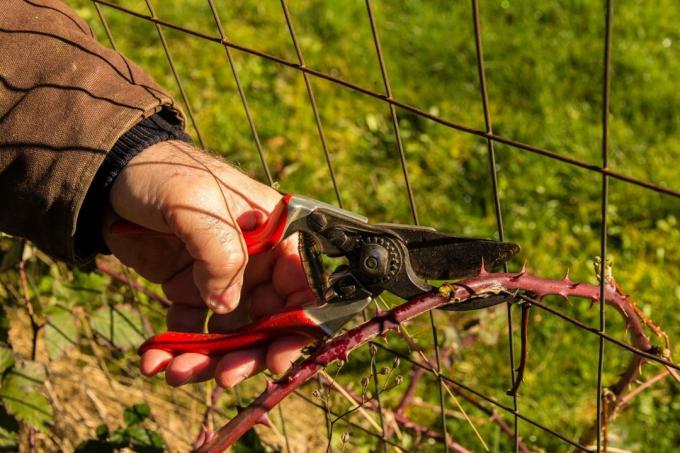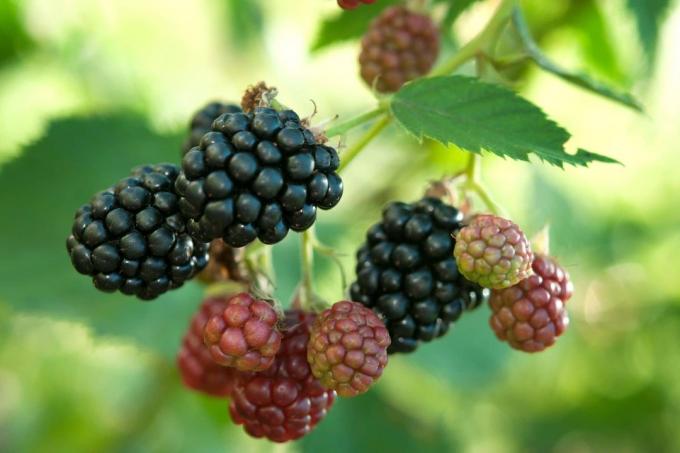
Table of Contents
- Cut diseased blackberries
- Spring is the best time
- summer cut
- fall pruning
- Frequently Asked Questions
Regular pruning is essential to ensure that blackberries (Rubus) bear plenty of fruit every year. The right time is important here, otherwise there is a risk of crop loss and, in the worst case, the plant dying.
In a nutshell
- always cut in case of disease or pest infestation
- Spring pruning is mandatory
- Cutting frequency depends on variety
- Summer pruning, especially in wild specimens
- Autumn pruning only in regions with mild temperatures
Cut diseased blackberries
Is a bramble through illness or pest infestation is severely weakened or pruning is required to combat it, this should be done regardless of the season. Action must be taken immediately if the plant's ability to survive is threatened. Pruning is possible even in winter, because a weakened blackberry usually does not survive the cold. Pruning back offers a good chance of getting them through the winter season stronger.
Spring is the best time
Basically, the best time to prune blackberries is early spring. Experience has shown that March is ideal. Depending on the weather, pruning can take place as early as the end of February if the late winter temperatures are mild.

Spring pruning is so important for blackberries because it removes "unnecessary" and annoying shoots. This results in a better supply of the fruit shoots and their growth is stimulated.
The spring cut is always due regardless of the variety. Whether further cuts are recommended during the year depends mainly on the following properties:
- fast growing
- thornless
- overgrown
- heavily branched because of the high risk of compaction
Tip: Spring is also the best season for planting blackberries, especially for frost-sensitive varieties. Cutting immediately after planting is recommended because it promotes rapid growth.
summer cut
Summer pruning is a sensible measure for certain varieties and overgrown specimens. They usually grow fast and strong, sometimes with numerous branches. These can ensure a high density. If there is a lack of light and air permeability, there will be bare trees and fewer fruit trees. In addition, the plants become more susceptible to diseases and pests. Therefore, such varieties should at least be thinned out between the end of July and the beginning of August. To encourage fruiting, the tips of young tendrils should be trimmed.
Varieties overview
Below is a list of the most well known sorts to be found that, in addition to the spring cut, also benefit from a pruning in the summer:
- 'Black Satin'
- 'Dorman Red'
- 'Theodor Reimers'
- 'Thornless Evergreen'
- all wild specimens

fall pruning
Fall is not the best time to prune a Rubus. Only in mild regions can the rods be removed from which the fruit was harvested. Otherwise there is a risk of frost causing the new fruit shoots to burst open because the old fruit shoots are missing as protection against the cold.
Notice: An exception is the columnar blackberry 'Navaho'. After the harvest, the harvested fruit shoots can be cut off until December. The young rods are then tied to a stake to stabilize them, protecting each other from the cold.
Frequently Asked Questions
The best time for this is also in the spring. Strong-growing varieties in particular should always be pruned radically in early spring on a frost-free day. Then only three or four young rods remain. The rest should be cut off near the bottom.
No. With an autumn cut, the missed spring cut cannot be made up for because the growth and harvest season is already over. You can therefore wait until next spring and avoid possible frost damage to the new fruit shoots.
This is also in early spring. If it is a fast-growing variety, it should be cut again in summer.
